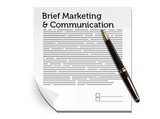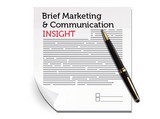Marketing & Communication Briefs: precision is your ally

The Marketing Brief, along with the Communication Brief, are essential tools for creative teamwork, from the initial design stage right through to communication to the target audience.
Briefs are therefore media that deserve your fullest attention, both for in-house purposes and for your relations with outside agencies and consultancies.
The utmost precision with regard to the insight and your target population is a determining factor.
In what context are Briefs used?
Marketing Briefs and Communication Briefs are key tools when launching a new product or service offer. Forming part of the essential "logbook" of your project, these documents make it possible to ensure step-by-step coherence with the different players who contribute to the launch. Certain companies have one single document which accompanies the entire project while others have separate, specific documents for Marketing and for Communication. This may depend upon the size of the company, its internal organization but also on the kind of relations that it has with its outside agencies.
The Marketing Brief makes it possible to align the different in-house contributors to your new product or service, from initial R&D right through to pre-launch Communication. The Brief may be amended as the project progresses, if the situation changes or the technical feasibility of the project evolves. In all cases however, the Marketing Brief must provide a clear record of the purpose of your project and the solution that it proposes.
The Communication Brief on the other hand comes into play towards the end of the process, once the feasibility of project has been clearly stabilized and your product or service offer is ready for launch. This document is primarily intended for your communication agency in order to provide them with the key information that they will require to produce impactful creative ideas for your communication media (print, films, banners, posters, etc…).
Show me your Brief, I will tell you how you work…

Whether we are talking about a Marketing Brief or a Communication Brief, this document speaks volumes about the stage of maturity of your thought processes. The more it is specific about the targets, the insights, the benefits, features, characteristics and elements of proof, the more it will clearly convey the messages that you wish to get across and enable the different contributors to have a more in-depth awareness of the ins & outs of your project.
However precise and specific your briefs may be, there is always room for new suggestions. Such flexibility will depend to a greater extent on your project management mode than the efforts you will have made to make your brief as precise as possible. In other words, be precise, but remain agile, or, to put it another way, a fuzzy brief is by no means the proof of an open and agile approach! Even when using the Design Thinking approach, with a series of iterations, it is important to be as precise as possible about each iteration. Indeed, it is essential that your brief will enable each new contributor to your project to understand exactly where and how you stand.
The role of insights within the Brief

The insight is a key element of a Marketing Brief because it determines the purpose of your product or service offer. It is important to remember that this insight will not be limited to a simple need (since not every need requires a new response). The insight must be as precise and specific as possible, a clear statement of your awareness and understanding of the consumer stakes. We recommend the use of our SMT method for drafting your insight; this method is sufficiently precise to avoid any misunderstanding or misinterpretation which could hinder the progress of your project. This marketing insight is not intended to be a creative work of art; it is moreover a shrewd analysis of a current reality or market trend. The time for creativity will come with the response that you will fashion for this insight in the form of an inspiring value proposition.
Mention of "insight" inevitably evokes the notion of target, given that the insight is the evocation of a consumer stake that is inextricably linked to one or several targets. This is why it is so important to be as precise as possible with regard to your targets and their respective insights.
Your value proposition: the benefits, advantages, characteristics and proof of what your solution has to offer in response to these insights.
Special care must also be taken to avoid drafting "made-up" insights, which would only serve to artificially legitimize the purpose of your product or service offer. The insight must be true, in tune with reality and closely linked to your value proposition.
The brief will of course contain a certain amount of other information, especially in the part devoted to communication (channels, media, budget, etc…). However, always bear in mind that your targets and your insight constitute the fundamental basis of a sound value proposition.
The balance of power and influence with the agency

As far as your communication brief is concerned, the degree of precision, or lack of it, will have a key impact on how your offer is received by the market. A highly precise brief indicates to the agency that your marketing thought processes have been very thorough. The more your views and choices are substantiated by actual facts (e.g. sources of your market data…) the greater your scope of impact when discussing your project with your agency. On the other hand, the more your brief is vague and imprecise, the more the agency will have to fabricate its own version of your value proposition. The precision of your brief thus plays a crucial role in the balance of power with your communication agency.
The fundamental question posed by this balance of power is as follows: will the design team come up with a solution in line with the brand's product strategy?
The more your brief is "woolly" and unclear, the more your agency will have to compensate for the lack of information with its own data and its own inspiration (in terms of consumer needs, the target audience or the product benefits). What guarantee will you thus have vis-à-vis the soundness of your value proposition? There is a real danger here of missing out on the genuine market opportunities owing to the fact that your value proposition has been replaced by a vision inspired by advertising-oriented creative thinking.
The more precise your brief, the more the creative processes can be channelled. This does not however imply that creativity will be curbed: once again, it all depends on the advertiser's attentiveness and the pertinence of the creative lines that are provided. With a precise brief you will have a clear message that your communication people will be able to make more impactful by means of an inspired creative approach.
Clarify your targets and insights at the earliest opportunity

Certain advertisers rely on their communication agencies to deal with certain issues that need to be resolved at the very earliest stages of the project, e.g. consumer insights, target identification and sometimes even the wording of the value proposition. More often than not however, the agency's work comes in the latter phases of the project, at the moment where there is little time remaining to form deep-seated convictions, which require a certain sense of detachment. The agency thus finds itself in a sticky situation, having to urgently deal with marketing conception issues as well as advertising creativity issues. And all of this within a particularly tight schedule, with no control whatsoever over the initial challenges and stakes of the launch.
The advertiser must therefore ensure, right from the outset, when drawing up the roadmap and drafting the marketing brief, that they clarify their targets and insights. These key elements constitute the raison d’être of the new offer, from a market point of view. Of course, certain adjustments may be made once the project is ongoing, but the vast majority of the necessary groundwork on the fundamental issues will have been done, so that when the time comes to deliver the communication brief, the agency will have at its disposal all the parameters it requires to focus its creative efforts on the company strategy and the product.